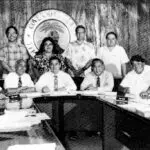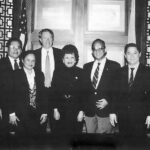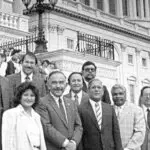Commission on Self-Determination
Table of Contents
Share This
Editor’s note: A provocative presentation on the issue of self-determination is provided to Guampedia in an interpretive essay by CHamoru scholar and activist, Ed LG Benavente, and can be accessed here. A legal analysis of Chamorro and Hawai’ian rights to self-determination can be accessed here.
In the 1980s and 1990s, the Government of Guam created the Commission on Self-Determination (CSD) to continue the quest for a change in Guam’s political status as an unincorporated territory of the United States. There were two commissions mandated by law: the first was organized in 1980, and the second in 1984.
Guam’s political status and relationship with the United States government has been an issue ever since the island became a territory of the US in 1898. Ruled by naval governors appointed by the Department of the Navy for the first half of the 20th century, Guam leaders petitioned the US Congress for greater autonomy and civil rights which they believed were possible with a more clearly defined political status and the granting of US citizenship for the people of Guam. When the end of World War II brought no significant change in the administration of the island, Guam leaders once again took on the challenge to call for civilian government and American citizenship from the US government.
Although the Organic Act of 1950 finally organized a civilian government for Guam and granted US citizenship, there were still modifications island leaders thought were necessary to achieve greater self-government and representation in the nation’s capital. The congressional laws that allowed the people of Guam to elect their own governor, lieutenant governor, and eventually, a non-voting Congressional Delegate, led many on Guam to believe that great strides had been made toward self-government for the island. However, in the larger context of world events, Guam’s status as an unincorporated territory or colonial possession of the US pointed out the great disparity between the democratic principles espoused by most American citizens and the lived reality on the island of Guam.
The 1960s and 1970s saw Guam leaders wanting to examine ways in which to address questions of self-determination and decolonization, as they had seen happening in other parts of the world. Motivated by the United Nations’ Charter and Resolution 1514 (XV) which declared the inherent right of peoples in non-self-governing territories to determine their political future, island leaders sought to understand what a change in Guam’s political status would mean for the people of Guam, especially in light of the long-standing relationship the island had with the United States.
The two legislatively mandated Political Status Commissions of 1973 and 1975 had been created to assess Guam’s economic, environmental, social, cultural and political situation, as well as to gauge the needs and desires of the island’s residents. The second Political Status Commission had also organized a plebiscite (although without formal recognition by the federal government, it was nothing more than an opinion poll) to see where island voters stood on the various forms of political status options available. Additionally, two Constitutional Conventions (one in 1969 and another in 1978) had discussed the drafting of a constitution for Guam as an alternate approach to outlining the political present and future of the island. The Northern Mariana Islands had successfully negotiated their Commonwealth Agreement, and the different Micronesian islands of the US Trust Territory (TTPI) were also negotiating their compact agreements with the US government. Different facets of the island community emerged to discuss the possibilities of a changed political status with the United States.
In this air of activity and discussion, by the 1980s, island leaders felt that the failed effort to produce a constitution and the apparent lack of understanding on the various political status options by the general population warranted the formation of another body to move the effort for self-determination forward.
The first Commission on Self-Determination, 1980-1982
The confusion over the different political status options was apparent in the results of a survey conducted by the Legislature in March 1980, where none of the five options—status quo, statehood, independence, commonwealth or free association received more than half of the votes. Although status quo received 39% of the vote,8 more than 14% of the voters said they were “unsure.” The survey did reiterate the desire on the part of many residents that Guam have greater control over immigration and economic opportunities. They also wanted the return of lands taken by the federal government. Opposition to change Guam’s political status was often expressed in terms of Guam’s important strategic location for the US military’s interest in the geopolitics of the region.
Nevertheless, by May 1980, Governor Paul M. Calvo signed legislative Bill 417 into Public Law 15-128, creating the first Commission on Self-Determination (CSD) for the People of Guam. Similar to the Political Status Commissions of the 1970s, the Commission on Self-Determination was tasked with gauging the desire of the people of Guam as to their future relationship with the United States. The commission then had to organize a task force for each political status option and conduct a public education campaign on the advantages and disadvantages of each status. After the campaign was completed, the commission was to conduct a plebiscite to establish the people’s choice. The plebiscite initially was scheduled for 12 September 1981, but was later changed to 30 January 1982. There were seven available options for consideration, including: Statehood; Independence; Free Association; Territorial Status with the United States; Commonwealth Status with the United States; Status Quo; and Other (for writing in other options not listed).
The Commission was comprised of eleven members, with the Governor of Guam serving as Chair. Five of the members were appointed by the Governor; the Legislative Speaker appointed three and the Commissioners’ (Mayors’) Council appointed two. A later law added two more appointees each for the governor and speaker.
With the formation of the commission, significant questions of debate arose: Who is Chamorro and how are they identified? Who is the “self” in “self-determination?” Does the right to self-determination only apply to the Chamorro people? Should non-Chamorro residents be considered in this process? Much of the debate became heated as opposing sides emerged. Activist organizations and other pro-Chamorro supporters advocated that Chamorros should be the primary participants in any effort at self-determination. Meanwhile, vocal non-Chamorro US citizens opposed this notion and felt the vote should include everyone.
After much discussion the Commission agreed to define a Chamorro as “all those born on Guam before August 1, 1950 [the date of the Organic Act’s passage] and their descendants.” Some people, however, felt this date should go back to 1898 when Guam was ceded to the United States, while others, particularly Chamorro activists, felt this definition denied the existence of the Chamorro people as a distinct ethnic and cultural group and the indigenous people of Guam.
The Commission’s efforts to educate the public were challenging as well. Members could only speak about the different status options in general terms, while the public wanted more specific details of what a change in political status might mean for the island. The task force papers describing the different options were published and circulated through the local media.
The question of who is the “self” in “self-determination” was most problematic for the Commission. Commission member and former senator Richard F. Taitano believed that defining this term was important. He had wanted the definition to include those people who had descended from the Chamorro people that were colonized by Spain and then the United States. When he saw that the Commission was not willing to speak to this issue, Taitano walked out and never returned.
As the Commission made some progress in their work, the question of Chamorro self-determination continued to be a major issue. Chamorro activist groups who had opposed the draft Guam Constitution in the late 1970s came out to vocally support Chamorro self-determination and Guam’s decolonization from the US. Opponents to Chamorro self-determination, meanwhile, believed this to be racially biased and discriminatory. The more the Commission debated this issue, however, the more they realized that indigenous rights would be a part of any effort to changing Guam’s colonial status, and they recommended to the Legislature in November 1981 that they recognize the indigenous right to self-determination.
Around this time, the Organization of People for Indigenous Rights (OPI-R) emerged and began to work together with existing organizations the People’s Alliance for Responsible Alternatives (PARA) and the Guam Land Owners movement to advocate for indigenous Chamorro rights. OPI-R set up their own educational campaign and opposed the plebiscite unless it recognized the Chamorro right to self-determination.
Although the Legislature did not recognize the Chamorro right to self-determination, OPI-R continued to lobby support from the UN and the Special Committee on Decolonization. OPI-R, however, unsuccessfully tried to stop the plebiscite from happening with a court lawsuit shortly before the plebiscite took place in January 1982.
The results of the plebiscite showed overwhelming support for commonwealth status, with statehood in second place although only a small minority of eligible voters actually participated. A runoff was conducted between the two options in September 1982 when there was greater voter turnout during the primary elections and again, the commonwealth option received the most votes.
With the decision made, the Commission put together a draft Commonwealth Act and submitted it to the newly elected governor of Guam, Ricardo J. Bordallo, who was serving his second (nonconsecutive) term as governor. Bordallo, along with Congressional Delegate Antonio Won Pat, tried to work with federal officials on the draft Commonwealth Act, but was met with no response from the Reagan administration. Island leaders then turned to the US Congress for support and assistance. In 1983, at a meeting in Albuquerque, New Mexico, Governor Bordallo and Delegate Won Pat met with Congressmen Manuel Lujan and Morris Udall to discuss how to bring the draft Commonwealth Act to Congress. Despite the meeting’s positive outcome, it became apparent in the next few months that the US Congress was not willing to have Guam proceed with their quest for commonwealth without the involvement of the US government in exercising their control over the terms of the act.
The second Commission on Self-Determination, 1984-1986
In January 1984, the 17th Guam Legislature passed Public Law 17-42 establishing the second Commission on Self-Determination. The Commission was tasked with producing a single document to be submitted to Washington, DC and that a vote on the commonwealth draft would be held before it was submitted to Congress.
In the new commission, the governor maintained his role as chair. The Legislature’s minority party would have one representative, while the majority had two. The Presiding Judge of the Superior Court or his designee would be another member. The Commissioners’ Council representative, as well as three at-large members were included in the Commission.
The CSD debated on whether to use an approach supported by Governor Bordallo involving Congress directly in the process. However, two commission members, Senator Francisco Santos and Marilyn Manibusan opposed this direction and wanted instead to negotiate an agreement with the White House. They believed this would lead to a more sovereign Guam and a better chance for the commonwealth status to be enacted. OPI-R voiced the opinion again that any document submitted to Washington should recognize the right of the Chamorro people for self-determination.
The Commission produced four working drafts of the Commonwealth Act but working Draft No. 4 was the one submitted to Congress in 1985. Major revisions were proposed that would result in continued federal oversight and less control by Guam leaders in matters involving military bases, congressional legislation affecting Guam, duty-free restrictions and other issues. OPI-R pushed for other changes to the draft, demanding the inclusion of Chamorro self-determination and controls on immigration. Other proposed revisions involved issues of land and access rights to federally-held properties.
By 1986 and 1987, the local elections brought some changes to the commission membership. Governor Joseph Ada took over as chair and some CSD members were replaced. The group decided to move forward with the draft and scheduled a plebiscite for August 1987. A lawsuit was filed by a local attorney in Superior Court to delay the plebiscite, but the suit was dismissed and the plebiscite continued as scheduled. Only 39% of Guam voters participated and the Commission decided to rewrite some of the articles that had been rejected, including one that involved Chamorro self-determination and another involving immigration control. A special election was held in November with a 57% voter turnout. The document was approved in its entirety and the Commission submitted the draft Commonwealth Act to Congress in February 1988.
The Commonwealth Act, however, was not well received by members of Congress as well as the White House. Objections focused on the perception that certain provisions of the Act were unconstitutional. Still, the Commission managed to get some members of Congress to support it. Commission Chair Joseph Ada also managed to get the draft act to President Ronald Reagan at a White House reception for the different state and territorial governors.
Over the next few years the draft Commonwealth Act was submitted continually to the US Congress during the tenures of Delegate Ben Blaz (1985-1992) and Delegate Robert Underwood (1993-2002), but languished during the administrations under President George H. W. Bush and President Bill Clinton. The Commonwealth Act remained at a standstill in 1997. The major objections again had to do with Chamorro self-determination, immigration and labor control.
In 1997, the work of the Commission on Self-Determination was transferred to the newly organized Commission on Decolonization by the 24th Guam Legislature. With the Guam Commonwealth Act off the table, the new body was tasked with determining the needs and desires of the people of Guam and to design a public education campaign on the options of Independence, Free Association and Statehood. A decolonization registry was created to register voters who would participate in an upcoming plebiscite on Guam’s political status, which has yet to be scheduled. The Commission on Decolonization has had its own set of issues and challenges and their work is ongoing. Nevertheless, the experiences of the two Commissions on Self-Determination demonstrated the complexities of the decolonization process, complexities that run deep in places such as Guam with such a long colonial history.
For further reading
Ada, Joseph, and Leland Bettis. “The Quest for Commonwealth, the Quest for Change.” Kinalamten Pulitikåt: Siñenten I Chamorro (Issues in Guam’s Political Development: The Chamorro Perspective). The Hale’-ta Series. Hagåtña: Political Status Education Coordinating Commission, 1996.
Leibowitz, Arnold H. Defining Status: A Comprehensive Analysis of United States Territorial Relation. Leiden: Martinus Nijhoff, 1989.
Rogers, Robert. Destiny’s Landfall: A History of Guam. Honolulu: University of Hawai’i Press, 1995.



